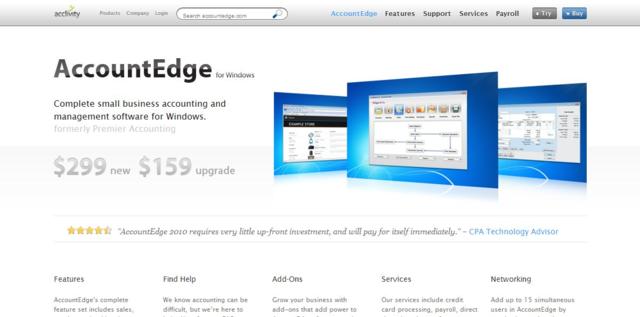
Although AccountEdge for Windows, retailing at $299, may not as famous as QuickBooks, $399.95, it is now and has always been a marvelous accounting program for smaller businesses, since its beginnings on the Mac in the early 1990’s, under the name MYOB. Acclivity bought the product more than a year ago, and the 2010 edition is named AccountEdge 2010; there is also a version available for Macs. This edition has the distinction of possessing the simplest, most contoured and user friendly interface to ever grace an accounting program for small businesses. It further boasts a feature set and navigational tools that are sturdy enough to offer serious competition to the QuickBooks and Peachtree desktop versions. Although it does suffer from a shortage of connectivity features, the standard online bill payment being one of them, it does show us new online marketing tools.
It has matured very gracefully in terms of appearances, especially when compared to Peachtree. Although both programs have been around for decades, AccountEdge, currently in its nineteenth version, is as sharp and unchanging as it was when it debuted. In comparison, Peachtree has a fuzzy appearance, although QuickBooks does still look very good.
In common with Peachtree and QuickBooks, Account Edge has built an interface which surrounds a series of cores: Inventory; Accounts; Sales; Purchases: Banking; Time Billing; and Payroll. These sensible divisions will go a long way towards simplifying your working day, although they are much incorporated.
In common with purchase orders, AccountEdge’s forms resemble their counterparts on paper, with simply a larger amount of functionality inbuilt. Dropdown indexes and simple information entry fields allow access to tasks that are related, with buttons along the bottom of the window providing this. For example, when working on a purchase order, you can either use or save the document as one that is recurring; obtain information on currency; open the journal; alter the layout; as well as view the register.
The remainder of the program works in a similar elegant fashion. It’s the most attractive of the programs available for small business accounting, and its interface is easy to understand.
AccountEdge’s appearance and navigational abilities are matched by its telling practicality. While inside the Sales module, you are able to create modifiable invoices; orders; and quotes and assign details like shipping methods for items; sales tax and freight charges. Documents can be faxed; printed; or emailed, and it is further possible for you to create statements and record the receipts of payments received by way of credit card, if you have established a merchant account. It is here that the sales register is accessible as well. The tabbed window allows users to toggle between indexes of credits; quotes; returns; orders; and invoices that are either open or closed. It does not allow consumers to attach supporting documents, although QuickBooks and Peachtree both do, but this is still a more than adequate collection of characteristics for sales functions. QuickBooks provides tools that are similar, even though it does so by means of dissimilar software rules. The Purchases module acts in a similar flowchart driven way, albeit with different forms like purchase orders, although it does have some other additions. You are able to settle bills by the printing of checks or the dispatch of electronic payments, and, while this is a beneficial feature it simple does not begin to compare to the complete internet banking offered by Peachtree. It is also possible to print 1099 and 1096 forms.
Time billing is also important, and AccountEdge is a significant competitor for Peachtree and QuickBooks in this field, although QuickBooks does allow employees to fill in timesheets and submit them on the internet. In AccountEdge, users build an index of billable processes and enter them onto individual or collective activity slips; then go on to make invoices charging clients for work that has been completed. It is also possible to make timesheets from nothing; copy the information from a previous timesheet onto a current one; or make use of recurring payment details.
Peachtree and AccountEdge supply the most advanced tools for inventory tracking available for small business accounting software programs. Stock records are very detailed, and allow the user to define each individual item exhaustively, with this module supporting various assemblies and price levels. You are able to record locations; display the history an individual item; track item quantities; and use customized fields to personalize your records to an even greater degree. Once these records have been created, you will just select one from a list when you’re gathering invoices, and AccountEdge will continue counting in the background so that you do not run out. QuickBooks is far less sophisticated, even though it does include tools that track inventory and non inventory parts; services and inventory assemblies also.
Fresh features include an enhanced Command Center; the automatic calculation of the profitability of a sale; and extra item attributes, like the ability to attach as many as 3 images to a product. Sales tax reporting has also been amended, and the consolidation of Google Maps into your cards of contacts has been added. AccountEdge is able to print the slips of bank deposits, and allow the user to back up and share files in ZIP format.



